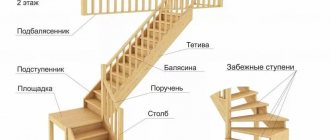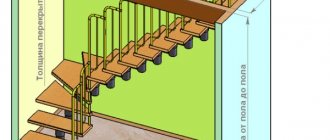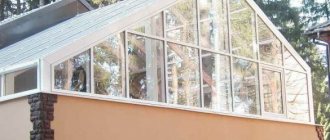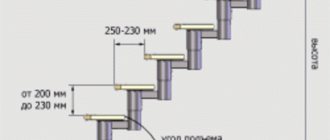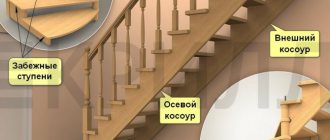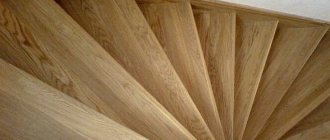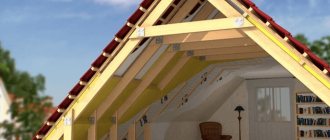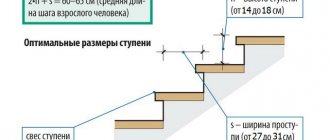Ladder - This is one of the most important structures in any private house, as it is the basis for free movement between floors. When choosing a project, craftsmen are often guided only by the economic and aesthetic side of the problem, often neglecting construction and design standards and rules. However, ignoring such an important component in many cases leads to the product being unstable, unsafe and uncomfortable.
The effective construction service KALK.PRO offers to perform an automated calculation of stairs online using a 3D calculator, as a result of which you will receive everything you need to install the structure: a comprehensive estimate, a full set of drawings and an interactive model for better visual perception. The program for designing stairs calculates the parameters of all elements and provides some recommendations based on the provisions of SNiP, GOST and TU , which are used for the manufacture of wooden buildings.
The program is easy to use and does not require special engineering skills - all fields of the calculator are intuitive, and the help includes illustrations with the designations of individual elements. Each calculation is accompanied by an assessment of the resulting structure and if incorrect values are entered - in case of critical deviations, the calculation will stop and a pop-up window will show in which field the error was made; if the deviation is insignificant, recommendations will be provided where the correction needs to be applied.
Use the calculator for calculating the stairs to the second floor to create a truly reliable and convenient design. Over 5 years of work, we have helped implement over 3,000 projects for residents of Russia, the CIS and Europe.
Why are our staircase calculators better?
Close cooperation with staircase manufacturers
Highest detail in drawings and 3D models
Final report with a list of required materials
Ready-made estimate for the construction of the structure by the contractor
Technical support helps when working with the calculator
Positive feedback and a large number of completed projects
Unlike other online staircase calculator sites, our project has a number of undeniable advantages and these are not empty words, since you can personally check all these statements in practice.
- Constructor functionality . You can design any type of structure and choose the features for fastening the elements. If invalid values are entered, the calculation will stop and a warning with an error will be displayed; on other resources, the calculation will be carried out in any case.
- Recommendations . Our calculator provides recommendations for many design elements, for example, you will find out the optimal parameters: angle of inclination, height of steps, width of the step board, tread width, staircase width, width of stringers (upper, intermediate, lower). On other sites - only the angle of inclination .
- Cooperation with manufacturers . Our development department works closely with real manufacturers of staircase structures, which is why we pay increased attention to detailing and fastening of individual components. Professionals and private companies use our tool everywhere .
- Ready estimate . As a result of the calculation, the user receives a final report, which contains all the necessary drawings, a 3D model in the selected projection and a ready-made estimate for the manufacture of the stairs, with a detailed description of the amount of materials . On other sites - only the dimensions of the elements.
- Graphic arts . Most visitors choose our site, among other reasons, because of the availability of high-quality, well-designed graphics. In addition to the fact that the drawings are as close as possible to the standards of technical documentation, the projection of individual elements in the diagram is selected in such a way that when cutting, the direction of the wood fibers (the seam of laminated boards) is maintained.
- Technical support . If you experience difficulties using the calculator or have questions regarding the resulting calculation, we will look into the situation and try to answer any constructive questions 24/7.
- Personal Area . Also on our website there is a convenient personal account in which the results of calculating a staircase or any other structure are saved - you will never lose your project, and you can also download the download at any time, regardless of the time of the operation.
Every month we receive dozens of positive reviews and thanks from users of the KALK.PRO project. On the “ Reviews ” page there are ready-made designs of structures made based on the calculations of our tools.
Walking line and middle marching line
The traverse line ( A ) is a horizontal projection of a person's imaginary movement along the steps. Passes at a distance of 300-500 mm from the inner edge of the stairs. This average size determines the comfort of using the handrail . Children will walk closer to the railing, adults - further .
Sometimes for a straight march this size is neglected, since the edges of the steps are parallel .
If the width of the stairs is up to 1000 mm, then the running line will coincide with the middle line of the flight. If more than 1000 mm, then the travel line shifts towards the handrail. The calculation algorithm is as follows:
- Using chalk or a plumb line, mark the intended route line(s) on the floor. Record the size with a tape measure and correlate it with the height of the stairs. It’s great if the travel line 1.7 greater than the height , which means the slope will be 30 °.
- Next, divide the line by ( n-1 ) for each proposed step rise option.
- all obtained tread size indicators using the Blondel formula to determine the optimal one.
Designer capabilities
The service provides a large number of proven tools, using which you can create a convenient, reliable and safe design. In its calculations, the 3D staircase designer algorithm takes into account the data of GOST 23120-78 “Flight stairs, landings and steel railings”, GOST 25772-83 “Steel railings for stairs, balconies and roofs”, GOST 9818-2015 “Flights and landings of reinforced concrete stairs”, GOST 8717.0-84 “Reinforced concrete and concrete steps”, SNiP II-25-80 (SP 64.13330.2011) “Wooden structures” SNiP 21-01-97 (SP 112.13330.2011) “Fire safety of buildings and structures”, SNiP 31- 02-2001 (SP 55.13330.2010) “Single-apartment residential buildings”, SNiP 2.08.01-89 “Residential buildings”, SNiP 2.08.02-89 (SP 118.13330.2011) “Public buildings and structures”, SNiP 2.01.07- 85 (SP 20.13330.2010) “Loads and impacts”, etc.
Currently, the program offers calculations for the following types of structures:
- wooden stairs;
- metal stairs;
- concrete stairs;
- stairs on stringers;
- stairs on broken stringers;
- ladders on bowstrings;
- the stairs are straight;
- turning stairs;
- spiral staircases;
- stairs with winder steps at 90°;
- staircases with winder steps 180° (double-flight);
- staircases with winder steps 180° (three-flight);
- stairs with a 90° turning platform;
- staircases with a 180° turning platform (double-flight);
- staircases with a 180° rotating platform (three-flight).
The tools on our website are the best assistants when calculating stairs - the calculator software is constantly updated and improved, so only here you can find exclusive functionality for creating the most realistic project. Among the main features we highlight (– only on KALK.PRO ):
- Units . Ability to select units of measurement (mm, cm, m, inches, feet), as well as their automatic translation in the calculator fields and results without recalculation by the user.
- Drawing color . Possibility of choosing color or monochrome drawing of drawings. May be useful for people with disabilities and when it is necessary to increase the contrast of individual elements.
- Staircase configuration . Possibility to select the side of the staircase (right or left).
- Stair parameters . Standard fields for entering design parameters (height, length, width).
- Definition of an opening . The calculators have functionality for selecting a direction (segment) along the outer edge of the staircase (upper, intermediate or lower flight), which will be taken as the length of the staircase.
- Distance between marches . When calculating U-shaped stairs with a platform, you can specify the distance between the flights.
- Stringers (for stairs on stringers). You must enter the thickness and width of the stringer. Also, only here you can choose the number of stringers (1-5 pieces) for winder stairs.
- Bowstring (for stairs on a bowstring). You must enter the thickness and width of the string. We also take into account the heel margin and the bowstring width margin (front, back), and the drawings are presented in two projections.
- Turntable size . Only here you can change the depth of the turntable to an arbitrary one.
- Fastening winder steps . Possibility of choosing the type of fastening of the rotary steps to the support post (tenon-groove connection, connection with a cut in the support post).
- Number of winder steps . An exclusive functional feature of the designer that allows you to choose the number of rotary steps.
- Calculation of staircase steps . Depending on the calculator, you will need to enter the number of upper, intermediate and lower steps, their thickness and protrusion. It is also necessary to indicate whether the upper step is considered below the level of the second floor or not.
- Risers . It is possible to note whether the installation of risers is required and, if so, what thickness they will be.
- Support beams. You must enter the thickness and width of the stiffener beams.
- Support pillars. It is necessary to enter the value of the cross-sectional side of the support column.
- Stair railing. Fields for entering parameters of staircase enclosing elements: handrails (thickness, width, height), balusters (section side).
- Floor slab and walls. Parameters for a more realistic visualization of the proposed structure (protrusion above the opening, distance from the wall, thickness).
A well-executed design of a staircase to the second floor in a private house will save a significant amount of time and money on the construction.
Calculation results
As a result of calculating the stairs online, you receive a comprehensive estimate with the optimal consumption of materials (quantity, volume) and detailed characteristics of each structural element. However, the most important thing is that the convenience of the structure will be assessed according to the following parameters: the angle of inclination of the stairs, the width of the stairs, the number of steps, the height of the steps, the depth of the tread, the minimum width of the stringer/string); at the end of which you can make adjustments to the parameters and make a final decision on the need to use this type of staircase.
Calculations are carried out on the basis of classical mathematical logic using simple geometric formulas, so calculation errors are minimized, however, it is worth considering the rounding of numbers when displaying dimensions in the drawings. There is a direct relationship that determines that the accuracy of displaying the calculation result is higher when using units of measurement of a lower order, that is, for millimeters the error will be no more than 0.1 mm, and when choosing centimeters - ~1 mm, etc.
It is also worth noting some features when transferring dimensions from drawings to a real structure. Firstly, it is necessary to take into account the thickness of the cut, which has physical dimensions of several millimeters in width. Secondly, we must not forget about the cumulative error, an example of which can be demonstrated as follows.
A calculation was made of a staircase (in centimeters) with 10 steps with an opening height of 162.5 cm - as a result, in the drawings the height of each step was 16.3 cm. However, you can notice that if you make a reverse calculation by steps, you get 16.3 cm × 10 = 163 cm, which is actually 0.5 cm higher than the height of the opening. This situation arises due to the fact that when drawing on the drawings, values are rounded to the first decimal place, i.e., under the number 16.3 cm the value of 16.25 cm was “hidden”. To reduce such errors to a minimum, calculations should be carried out in millimeters , however, in some situations it will still be necessary to adjust the outermost structural elements when installing in height.
After authorization on the site, the results can be downloaded in PDF (full report), PNG (drawings + 3D model in a given projection), OBJ (3D model for further processing) formats. There are also options to send all calculations by email , save to bookmarks or share on social networks.
If you don’t know how to correctly calculate the stairs to the second floor with your own hands, use our design program!
Staircase drawing with dimensions
Staircase drawings are the most important component of any design documentation, as they allow you to record the design features of the elements and their connections. They also provide an opportunity to preliminary evaluate the parameters of individual design components in practice. That is, by making templates from cheaper materials, such as cardboard or paper, you can eliminate mistakes at the initial stage and save a significant amount of money on materials.
However, you should not assume that you can draw a staircase diagram yourself without proper experience in drawing and design. Without special training, you are unlikely to be able to maintain the dimensions of the drawings, maintain accuracy down to a fraction of a millimeter and at the same time show accuracy, maintaining the readability of each element. Professional computer programs AutoCAD, Compass-3D, CorelDRAW, etc. cost a considerable amount of money; in addition, without the proper operating skills, it will take a lot of time to even learn the basics.
The KALK.PRO service eliminates unnecessary difficulties and provides ready-made drawings of wooden stairs based on the user’s entered data. Our diagrams are distinguished by excellent elaboration of individual node connections and the entire picture as a whole; you can independently evaluate the high quality of graphics and compare it with other services.
3D model
A 3D model of the staircase allows you to examine the resulting structure in real proportions and evaluate the prospects for using the current project. Unlike drawings, a three-dimensional model is not intended for the production of structural elements, but it is capable of visually conveying the general idea of an object down to the smallest detail.
On our website, a 3D staircase design is drawn based on the user’s entered data with absolute accuracy without any distortions or errors . Zooming and controlling the camera occurs using the mouse - left and right keys, respectively. The three-dimensional model can be downloaded in the selected projection on the staircase calculator tab in PNG format, it is also possible to download graphics in OBJ format (supported by Autodesk 3ds Max, AutoCAD, ArchiCAD, PC LIRA...) for further editing.
What to think about before starting design
As in any other matter, before you start designing and drawing staircase structures you must:
- Decide which staircase to the second floor you want to equip.
- You should also think about what the material will be like. After all, stairs are presented on the modern market in a wide variety of variations.
- How much money are you willing to spend on this design? This question is also important, because it depends on what kind of project should be done.
- It is also worth considering the design solution of the staircase structure. Indeed, today there are many options offered on the market.
- Decorative details should also be thought through in advance, this will make it easier to calculate the amount required to equip the space.
All these nuances are important when creating a diagram of future gangways remotely through special programs.
How to calculate stairs online using a calculator?
To calculate a staircase with drawings using an online calculator, you need to go to the tab of the appropriate design and fill in all the fields based on the available opening parameters. However, first we recommend that you familiarize yourself with the proposed video, which describes in detail all the steps in the program and provides advice from a professional craftsman who personally manufactures stairs.
Calculating stairs online using a calculator from KALK.PRO means confidence in the quality of the structures being built due to the high accuracy of the operations performed.
Relative amount of rise of the march (elevation angle)
In construction practice, the lifting angle is usually in the range from 20 to 50 degrees, but stairs with an angle of 30 to 45 degrees are considered the most convenient.
Table of the dependence of step sizes on the angle of inclination:
| Width | Height | Tilt angle |
| 40 | 10 | 14°10′ |
| 38 | 11 | 16°20′ |
| 36 | 12 | 18°30′ |
| 34 | 13 | 21°00′ |
| 32 | 14 | 23°10′ |
| 30 | 15 | 26°40′ |
| 28 | 16 | 29°50′ |
| 26 | 17 | 33°10′ |
| 24 | 18 | 37°00′ |
| 22 | 19 | 40°50′ |
| 20 | 20 | 45°00′ |
The choice of inclination angle determines a margin of distance (critical height) of at least 2000 mm from any step to the ceiling or any protruding element of the building (beam, parapet):
It is convenient to check the critical height by drawing the calculated steps on any sheet material or directly on the wall. As design practice shows, very often a line drawn from the ceiling or a dangerous ledge will be less than the desired value.
It is for this reason that it is not possible to design a staircase that is shallow enough. As the angle of inclination increases, comfort decreases, therefore, with the low average height of all households, sometimes this size is underestimated.
But we still recommend adjusting the slope of the stairs or considering a different location for its installation. Going through layout options is a smart and common practice.
In the already mentioned work of Novitsky O.V. “Modern stairs. Design, manufacturing, installation.” a real practical case was considered, in which as many as 6 options for the location of the stairs in the room were consistently and reasonably considered.
In any case, the final result is usually a middle ground between many conflicting arguments.
Formulas for calculations
Example of a straight staircase diagram
To correctly calculate the main parameters, general formulas are used:
- Pythagorean theorem (2*a + 2*b = c*2). Used to determine the length of a flight of stairs, where a is the height of the opening, b is the length of the projection of the stairs and c is the length of the flight.
- Number of steps: N/h, where H is the height of the opening, h is the height of the step.
- Indicator of comfortable movement: 2h + T, where T is the depth of the tread and h is the height of the riser.
- Span length: K * h, where K is the number, and h is the depth of the step.
- Passage height. (H - 2000)/ h, where H is the height of the opening (mm), h is the height of the riser.
March width
The width of the flight is determined by the capacity of the staircase (the number of people per minute at the narrowest point) and assumes the comfortable movement of an adult.
For internal flights of stairs, building codes define this value (the size from the wall to the railing or between two railings on the left and right sides) as at least 900 mm, in luxury houses 1250-1600 mm.
There are exceptions for the width of the flight of stairs ( 0.8 m) of some types of stairs (for example, in garden houses), but when designing a staircase, you should focus on this size only in conditions of a severe lack of free space in the room.
Auxiliary structures can afford a width of less than 0.8 m , for example, a staircase to the basement or attic.
Terminology
Before developing a staircase plan, you need to be fully familiar with the names of the various models, as well as the constituent elements of the chosen design. For example, marching structures on drawings are always marked using straight lines. Spiral staircases are always drawn taking into account the support post, which is located in the center of the structure.
In this article you will learn how to make a drawing of a staircase
If you need to create a drawing of a spiral staircase, you will have to take into account some clear differences from the spiral design. In such a situation, the dimensions are always described by a circle, the internal support of which is located not in the geometric center of the structure, but at a certain distance from it.
Drawings of stairs with a turn have clear differences from the others in the form of the presence of 2 flight sections. Between them there are winder steps or sections with gaps. If the staircase is prefabricated, the drawing must include several identical structural parts.
When creating a drawing of a bolt structure, it is necessary to take into account that the load-bearing parts of the structure are the remaining elements connecting the steps to each other. They are what are called loaches.
Drawings of a finished fire escape always differ from standard designs in that they provide completely different sizes and angles of inclination. Sometimes they are designated as vertical, so that the master can decide how correctly the installation of this structure will occur in the future.
In this video you will learn more about the staircase drawing:
In addition to the differences when creating a drawing, it is worth considering that these designs may differ in the material used. It could be:
- tree;
- glass;
- reinforced concrete;
- metal;
- some types of plastic;
- artificial or natural stone;
- ceramic products.
Legend
A drawing of a staircase is a projection onto a plane. In order for the diagram to provide complete information, a plan and section are drawn up for each project. Both drawings must indicate the direction (where people will rise). The lowest point of the structure is marked with a circle, the top with an arrow.
To prevent confusion during construction, the materials used are indicated in the plan, in accordance with GOST 5401-50. Full information can be obtained in this regulatory document, so we will only talk about the most popular materials:
- Tree. On end sections it is indicated in the form of circular and radial strokes. On longitudinal diagrams in the form of longitudinal lines.
- Concrete. In any drawings it is indicated in the form of dots and circles of chaotic shape.
- Metal (any type). Indicated by dashes with diagonal lines. If the thickness of the element is less than 2 mm, markings in the form of a solid fill are used.
Symbols of building materials according to GOST
Structural elements
Before you start drawing a sectional view of the staircase, it is advisable to decide on the constituent elements. First of all, this includes the following:
- Flight of stairs. It is called a straight section located in certain areas of the structure.
- Tread or step.
This is the horizontal surface of the step. This is interesting: requirements for steps for stairs. - Riser. In other words, this is the vertical part of the structure that supports the treads.
- Stair stringer. This is a supporting element with steps on top of it. Often there are no more than 2 of them in any structure, but some structures require the presence of only one element.
- String for stairs. This is a beam into which the step cuts, but does not rest on it.
- Intermediate platform. This is an ordinary horizontal section.
- Winder steps. Each of them is an alternative element of the site, provided between the marches. In the drawings they have a trapezoidal shape.
- Clearance. This place is designated as the distance from one step to the elements that are located above the head.
- Middle line. It is called a virtual line along which people go up or down the stairs. If we are talking about a screw model, in this case the line will shift slightly towards the wider ends of the steps.
Building codes
- The main dimensions of the structure should not change. Otherwise, proper operating safety will not be ensured.
- Recommended opening width: 80-90 cm.
- The height of the railings (fences that prevent you from falling down) should be between 90-120 cm. They should be on both sides (an exception if the structure is adjacent to the wall).
- The depth of straight steps should be within 20-40 cm (optimal values 25-32 cm). Height in the range of 10-18 cm.
- The optimal slope angle is 45 degrees.
The remaining parameters are selected based on the room, materials used, type of construction and operating factors.
